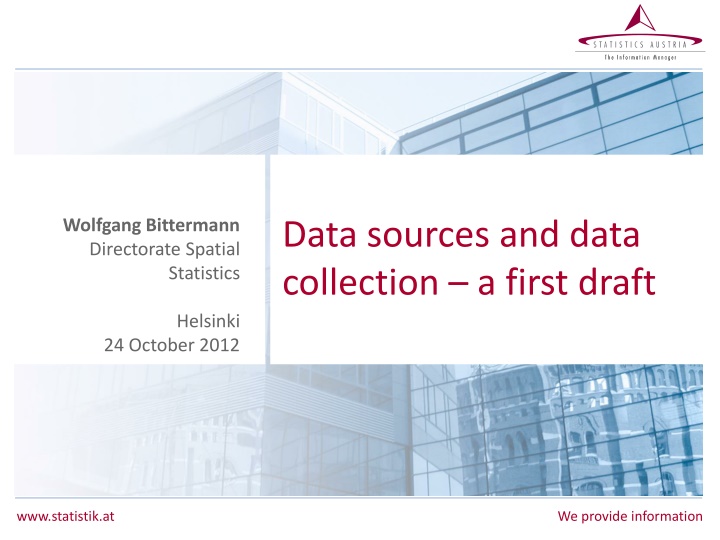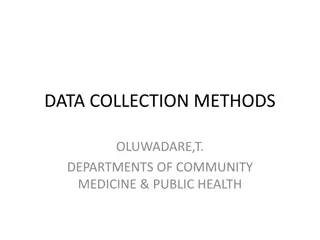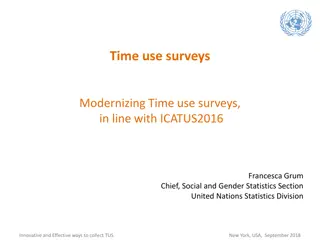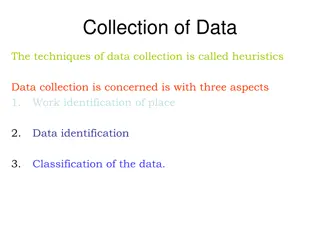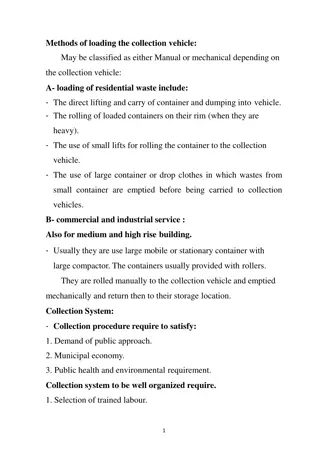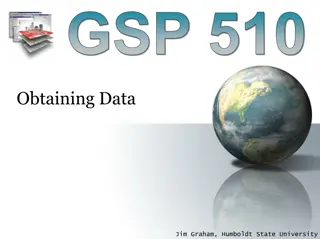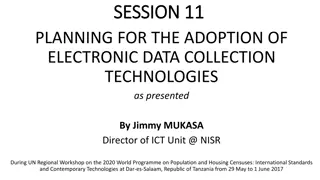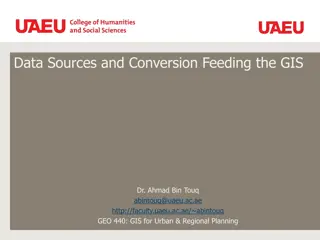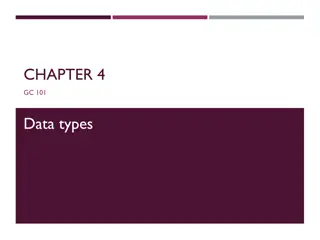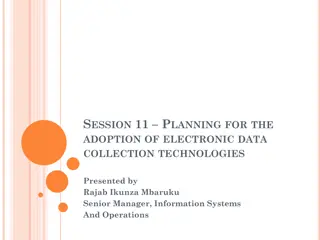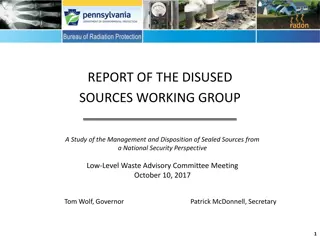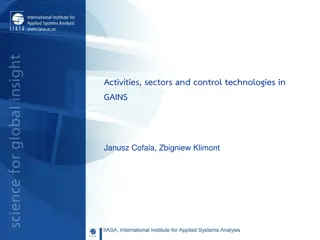Types of Data Sources and Collection Methods
This content presents an overview of different types of data sources used in statistical analysis, including administrative registers, surveys, smart metering, and models. It explores the advantages and disadvantages of various data collection methods, such as consumer surveys, and discusses the legal frameworks and formats involved in data gathering.
Uploaded on Mar 11, 2025 | 0 Views
Download Presentation

Please find below an Image/Link to download the presentation.
The content on the website is provided AS IS for your information and personal use only. It may not be sold, licensed, or shared on other websites without obtaining consent from the author.If you encounter any issues during the download, it is possible that the publisher has removed the file from their server.
You are allowed to download the files provided on this website for personal or commercial use, subject to the condition that they are used lawfully. All files are the property of their respective owners.
The content on the website is provided AS IS for your information and personal use only. It may not be sold, licensed, or shared on other websites without obtaining consent from the author.
E N D
Presentation Transcript
Wolfgang Bittermann Directorate Spatial Data sources and data collection a first draft Statistics Helsinki 24 October 2012 www.statistik.at We provide information
The content 3 Subchapters Types of data sources Data collection Country practices Open questions Extension: nr of pages, font type etc. Level of detail Links to other manuals e.g. Energy efficiency manual (IEA), MESH (EUROSTAT) vs independent publication 1. 2. 3. 1. 2. 3. www.statistik.at slide 2 | 24 October 2012
Types of data sources - Overview 1. Administrative data sources 2. New Surveys 3. Additional questions to already existing surveys 4. Metering Smart meters and smart grids In situ measurements 5. Models 6. (Integrated Approach?) www.statistik.at slide 3 | 24 October 2012
Types of data sources Administrative data 1. Registers for public administration Population register Housing register Building register Car register 1. 2. 3. 4. 2. Private registers Sales registers Customers registers 1. 2. 3. Tax information 4. Customs data www.statistik.at slide 4 | 24 October 2012
Types of data sources - New Surveys i. Legal base a. b. obligatory voluntary ii. Type a. b. Census Sample survey iii. Respondents a. b. Suppliers Consumers iv. Format a. b. c. Paper Web based (electronic questionnaire) Interview o Personal interview Computer assisted (CAPI) Non computer assisted o Telephone interview Computer assisted (CATI) Non computer assisted www.statistik.at slide 5 | 24 October 2012
Types of data sources General structure 2. New Surveys Advantages Disadvantages Legal base Obligatory Advantages Disadvantages Text Text Summery and conclusions b. Voluntary II. Type I. a. www.statistik.at slide 6 | 24 October 2012
Types of data sources Example Consumer Surveys (households) Advantages Comprehensive information on all fuels used in private households Best achievable data quality if they are well prepared and combined with a comprehensive data validation process Can be used directly and as input for model calculations Disadvantages Resource intensive Expensive Time consuming High respondent burden www.statistik.at slide 7 | 24 October 2012
Types of data sources Example Consumer Surveys Conclusions and summery The 4 main elements to achieve good results are a careful preparation, a simple questionnaire, well trained interviewers and comprehensive data validation. Grossing up procedures can be improved by using supplier information, e.g. gas meters attributed to households. Model based extrapolation e.g. heating degree days help decrease survey frequency. www.statistik.at slide 8 | 24 October 2012
Data collection - 1 1. General aspects Preparation/Questionnaire o Complexity o Length/Completeness o Structure o Necessary explanations o Announcement Data validation/imputation/grossing up o Comprehensiveness o Documentation o Use of additional information www.statistik.at slide 9 | 24 October 2012
Data collection - 2 2. New surveys/questionnaires User and expert implementation into questionnaire development Taking into account respondents knowledge Test survey Taking into account resource availability (budget, staff) and data quality aspects (by choosing type and sample size) www.statistik.at slide 10 | 24 October 2012
Data collections- 3 3. Metering When metering What metering o Electricity o Natural gas o District heating 4. Modeling When modeling What modeling Necessary preconditions www.statistik.at slide 11 | 24 October 2012
Country practices Harmonised format? How many examples? Results and metadata included? Directly implemented As annex As link What level of detail e.g. different levels already available for Austria (Metadata reports for UNSD, EUROSTAT, IEA, national) Shall quality aspects be included? Directly implemented As annex As link www.statistik.at slide 12 | 24 October 2012
IEA-Examples www.statistik.at slide 13 | 24 October 2012
Please address queries to: Wolfgang Bittermann Thank you for your attention Contact information: Guglgasse 13, 1110 Vienna phone: +43 (1) 71128-7315 fax: +43 (1) 28-8155 wolfgang.bittermann@statistik.gv .at www.statistik.at slide 14 | 8 March 2012
